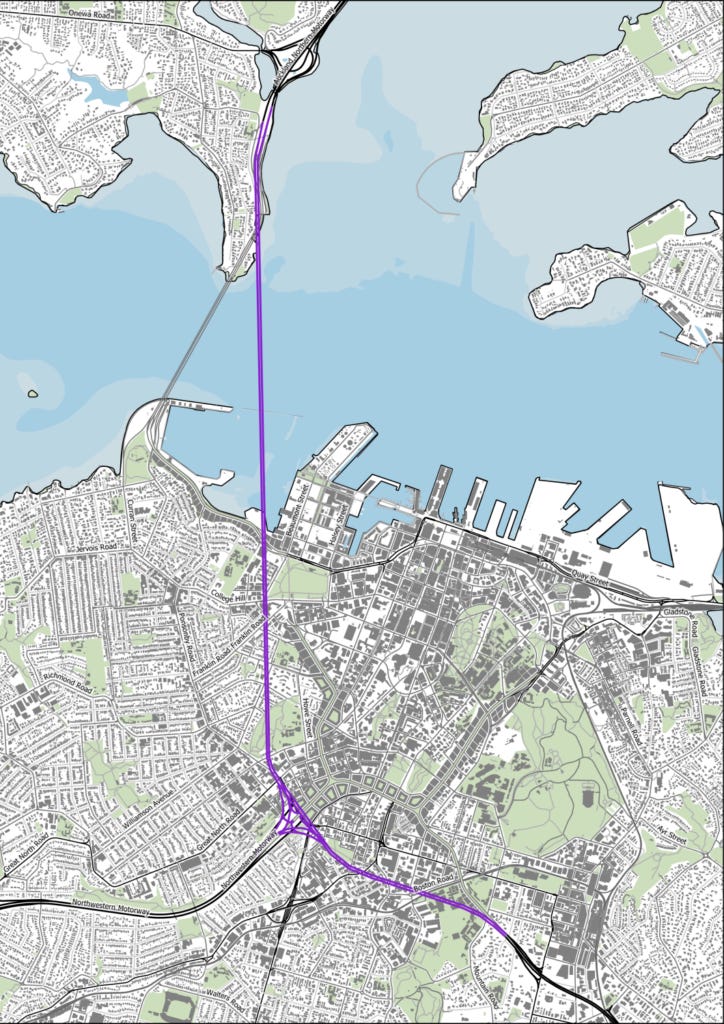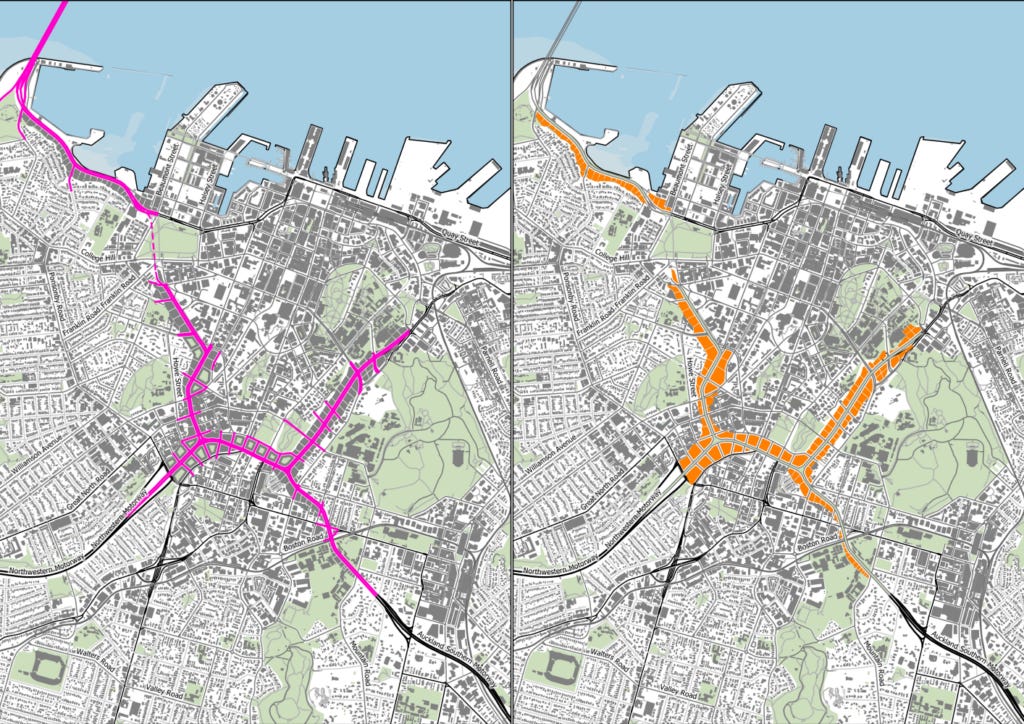This post by Nicolas Reid was originally published on Linked in. It is republished here with permission.
In this article, I make a not-entirely-serious case for ripping out Spaghetti Junction in Auckland, replacing it with a motorway tunnel, and redeveloping new city streets and neighbourhoods above it instead.
What’s the problem with the Central Motorway Junction?
The great irony of urban motorways is that they use up huge amounts of the very thing they are intended to access: land. This is the case for all surface transport infrastructure of course, however motorways are the worst offender. Even a small motorway corridor is at least five times as wide as a simple street, while the interchanges can be the size of a small town.
Nowhere is this consumption of valuable land more visible than at Spaghetti Junction in central Auckland, formally known as the Central Motorway Junction (CMJ). Here hundreds of homes and entire city neighborhoods were demolished and excavated to build it, plus the negative effects of noise, emissions and severance extend well beyond the junction itself. Spaghetti Junction is a noose around the neck of the city centre, lowering amenity and land values on the properties either side. But of course, in the transport space everything is a tradeoff. There are big accessibility benefits from having Spaghetti Junction, after all it does carry 200,000 vehicles a day. That is a whole lot of people doing a whole lot of things.
But despite its high traffic volumes the CMJ isn’t actually a very good motorway interchange. Ask any traffic engineer and they’ll tell you, it is an antiquated design built to the plans and standards of the 1950s… and that’s a headache for the 2020s. The ramps are too close together, the merges too short, the corners too tight. The junction almost completely encircles the city centre, yet you can’t use it as a ring road to avoid driving through the city centre. And critically, it forces regional through-traffic and city traffic onto the same lanes, ramps and merges. There’s an almost laughable reason for that, back in the 1950s they were concerned that not enough people would use the motorways if they didn’t lead downtown, so they intentionally combined through traffic with commuter traffic to share the same lanes.
A proposal to replace the city centre motorways
If we were building the motorways today we’d take a different approach. The regional motorways would be designed to bypass the city core entirely, linking to each other well clear of city streets. Meanwhile city traffic would exit the motorway early and carry on along arterial roads, while a proper ring road would allow traffic to drive around the city core rather than through it.
So I wonder, why don’t we do this? What would it look like if we linked the motorways with a bypass tunnel, rip out Spaghetti junction and replace it with surface streets and a ring road? That would mean better state highway traffic on the motorways, a proper ring road for the city centre, better city street connections, and most importantly, a big chunk of inner-city land available for redevelopment.
In a nutshell, here’s my proposal in three simple steps:
1. Build a new harbour crossing/city bypass motorway tunnel
This would start on the Northern Motorway at the old toll plaza just north of the harbour bridge and run to the Southern Motorway joining to the Newmarket viaduct, and connect to the Northwestern Motorway in both directions part way along.
It would be 6.9km long, six lanes in total, and have one underground interchange with the Northwestern near Newton Road, otherwise no other ramps or interchanges.
The harbour bridge would become an arterial road for access to the city centre only, with four lanes for city traffic, two for buses and two for walking and cycling.
2. Replace Spaghetti Junction with a boulevard ring road
Demolish the motorway junction and all of the motorway lanes and ramps through St Marys Bay, Newton Gulley, Grafton Gulley and Khyber Pass.
This gets replaced with a surface arterial boulevard around the city centre, reconnecting all the local roads and streets. In some places this widens existing roads like Union Street or Alex Evans Street, in others it is an entirely new road.
St Mary’s Bay becomes a waterfront avenue, Grafton Gulley a boulevard, Freemans Bay and Newton get filled back in with new avenues and side streets.
Victoria Park tunnel would be reconfigured for one lane each way for the new ring road, but the Victoria Park viaduct would be demolished entirely.
3. Build out the city on the former motorway land
Allocate an appropriate amount to new parks, public spaces and community facilities and sell all the excess land on the new streets for redevelopment.
The city bypass tunnel, harbour crossing, busway extension, land development all-in-one bonus jackpot
Easy eh, it’s just that simple. This would mean an underground motorway bypass of the city centre, a new ring road and a reconnected network of local streets, and a big set of development sites.
People driving on the motorway would skip right past the city, those driving to the city would exit the motorway at the harbour bridge, Newton Road or Khyber Pass Road to continue on the new ring boulevard and on to city streets. People driving in and around the central area would drive on main roads or the new boulevard without encountering a motorway at all.
Following these steps would make the map of Auckland look something like this:

What about the cost and benefits?
Ok, cool story bro, but what about the cost of this fantastic scheme?
Naturally this would be a big undertaking, easily the largest infrastructure project New Zealand had every faced. However, it would be technically feasible, there’s nothing unusual about digging motorway tunnels and building surface streets. So the viability really comes down to the cost. Let’s break out the elements to get a ballpark idea of how much.
The core piece is a six -lane motorway tunnel, 6.9km long with one major underground interchange. That’s a similar configuration to the Waterview tunnel project, but around three times as long. It’s also about the same length as the most recent harbour crossing tunnel proposal. Using Waterview’s cost of $600m per kilometre as a guide, I’m going to double it again to factor for construction cost inflation and major project risk, for a guestimated cost of around $8.2b for the tunnel proper. Add on the interchange with the northwestern and at either end, and we can call it $10b for the motorway component.
Add to that the cost of demolition of the current motorway and reshaping and stabilizing the land, say $500m, and of building 6.1km of new urban boulevard, reconfiguring the VPT and building 1.1km of local street connections for another $500m. With sundry other costs, let’s call that a mid-range estimate of twelve billion dollars. Pretty similar to harbour crossing proposals of about the same scale.
Alright, what about the benefits? Well as noted above, this would deliver a harbour crossing with an extra six lanes combined with a motorway bypass of the city centre, it would also separate city traffic from motorway traffic. It would give the northern busway its own lanes all the way to town, plus add walking and cycling across the bridge, and deliver a new ring road boulevard around the central city. There is undoubtedly a large bundle of transport user benefits in there. I haven’t calculated these all, but in simple terms the gain would need to be worth $480m each year to justify a $12b project. That works out to be something like $1.3m of net transport benefits each day to break even.
However, there’s a big chunk of land freed-up without the motorway wrapping around town, and that’s worth something. Right now, the central motorway junction takes up 615,000m2 of inner-city land, if we subtract the land needed for the new ring boulevard and connecting roads there is still a lot leftover, I’ve estimated 370,000m2. That’s about the same amount of land as the Wynyard Quarter, which gives you an idea of the development potential. Currently development land on the edge of the city centre is worth around $10,000 per square metre, so replacing Spaghetti junction with a ring road would free up development sites worth around $3.7b. Put the sale of that land on the ledger and it effectively knocks a third of the capital cost, meaning the net cost of the project would be around $8b. So now the break-even value of benefits is more like $880,000 per day.

A quick back of the envelope assessment shows we are dealing with 200,000 vehicle trips a day in and around spaghetti junction and the harbour bridge, plus about 40,000 bus trips a day coming over the harbour. So, to be worthwhile this project would need to be worth about $3.70 per trip for everyone affected. NZTA’s benefits and cost manual prices the value of commuters’ time at about $19 an hour, so we’re talking about the equivalent of every person saving twelve minutes on their trip. That’s pretty high for an average across all trips, but not absurdly so, which suggests that a closer look might be worthwhile.
In summary, is this a crazy idea?
When I started musing on this idea it was a bit of fun, an exercise in what you could do to fix the roads around central Auckland if money was no object. However, working out a few figures it seems that it might not be an entirely terrible idea, as far as motorway megaprojects go at least. The idea of using a harbour crossing to bypass the city entirely, and redevelop the surface motorway corridors into city streets and development sites, might actually be worth looking into further.
What are your thoughts? Let me know in the comments.
This post, like all our work, is brought to you by the Greater Auckland crew and made possible by generous donations from our readers and fans. If you’d like to support our work, you can join our circle of supporters here, or support us on Substack!




It's a good idea but of course fewer motorways just doesn't compute with the average car owner/councillor/politician! Couple of issues to consider. 1. is the traffic to the Port, putting every single truck going to/from the Port on the ring road sounds alarming. 2. I don't understand how traffic to/from the North would access the Port?
Sounds like a good idea. Over the years I have encountered many people scared of driving through Spaghetti Junction thus limiting access to many parts of Auckland and beyond. The Waterview tunnel goes some way to giving access to beyond Auckland so a central city tunnel and a ring road would expand horizons.